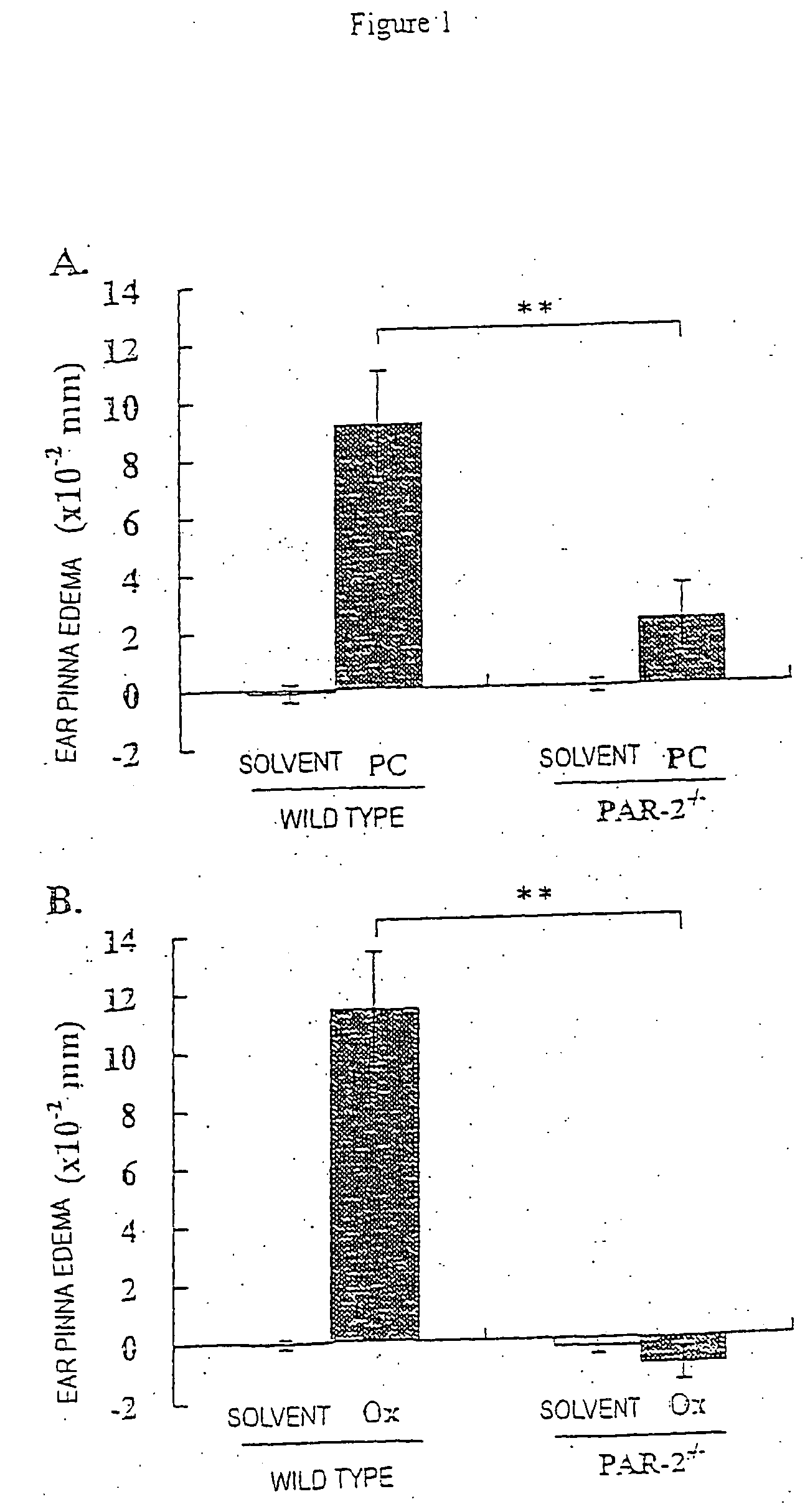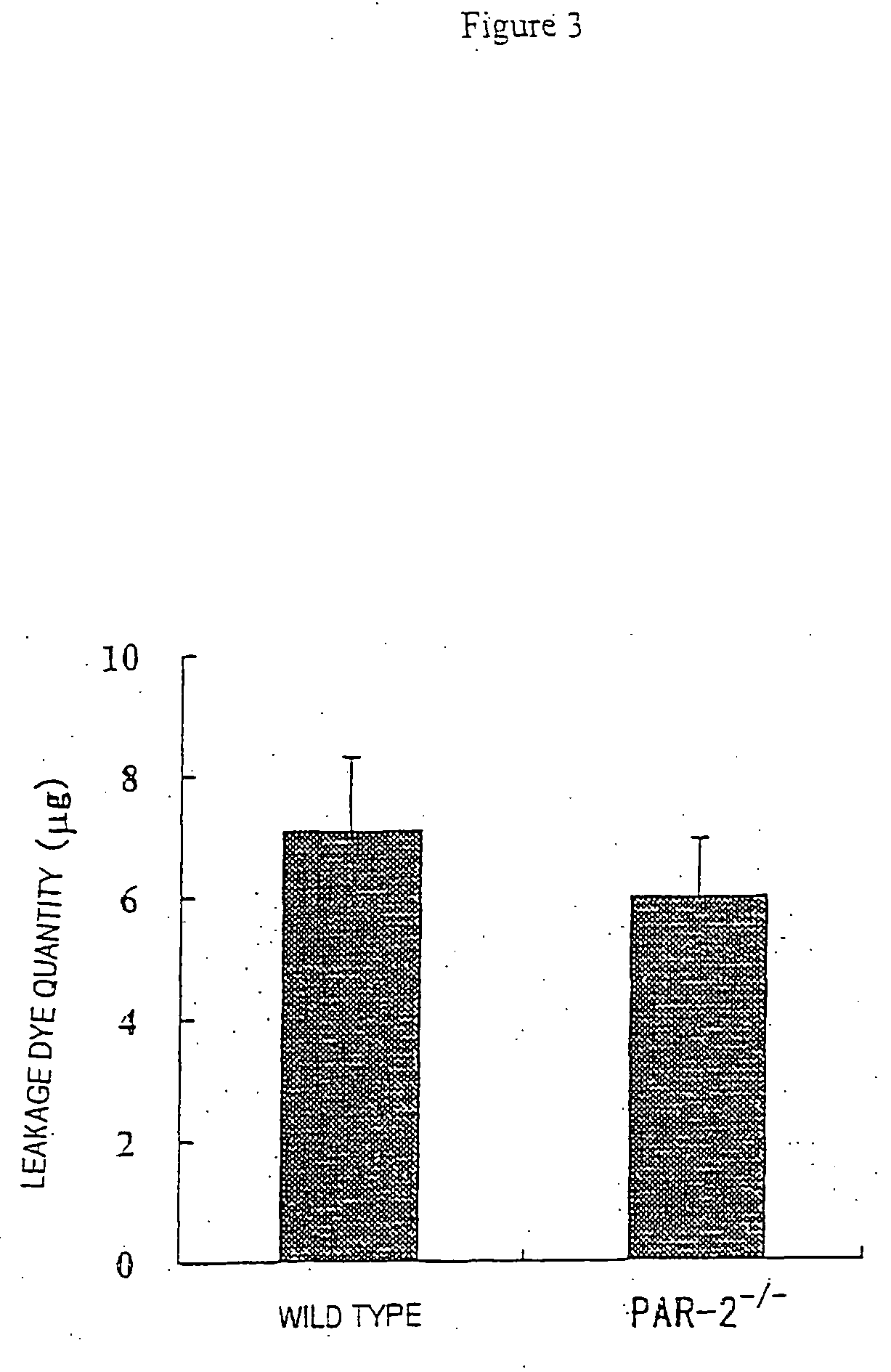Pharmaceutical composition for delayed hypersensitivity
a technology of delayed hypersensitivity and pharmaceutical composition, which is applied in the direction of extracellular fluid disorder, metabolism disorder, immune disorders, etc., and can solve the problems of tissue damage, local lesions, acute inflammation,
- Summary
- Abstract
- Description
- Claims
- Application Information
AI Technical Summary
Benefits of technology
Problems solved by technology
Method used
Image
Examples
example 1
[0059] The thickness of ear pinnas was measured in non-treated wild type and PAR-2− / − mice. The average values of each 10 mice are:
[0060] Wild type mice 22.7±0.4 (×10−2 mm; the mean±standard error)
[0061] PAR-2− / − mice 22.0±0.4 (×10−2 mm; the mean±standard error)
and no statistical difference was observed between the two groups. Also no difference was macroscopcally observed, indicating that inhibition of PAR-2 did not cause skin atrophy.
example 2
Picryl chloride (PC) (2,4,6-trinitro-chlorobenzene)-induced Contact Dermatitis Model
[0062] After shaving hairs, each 10 mice of PAR-2− / − and wild type groups were sensitized by applying 100 μl of 7% PC-ethanol solution on the abdominal part. After 6 days, the thickness of both ear pinnas was measured using a dial thickness gauge (Peacock G-1A, OZ-AKI MFG. Co. Ltd.). Then, induction was performed by applying 20 μl of 1% PC-olive oil or solvent alone on the both sides of the ear pinnas, and then the thickness of ear pinnas was measured after 6, 24, and 48 hours. The difference of ear pinna thickness before and after the induction was calculated to be an indicator of edema. The results are shown in Table 1 described below.
[0063] The result after 24 hours is represented as a graph in FIG. 1A. By applying PC on the ear pinnas of the wild type mice, incidences of edema were observed, of which peak was at 24 hours after the induction. Edema and rubefaction of the ear pinnas were also obs...
example 3
Oxazolone (Ox)
(4-ethoxymethylene-2-phenyl-2-oxazoline-5-one)-induced Contact Dermatitis Model
[0064] After removing hairs, each 5 mice of PAR-2− / − and wild type groups were sensitized by applying with 100 μl of 0.5% Ox-ethanol solution on the abdominal part. After 5 days, the thickness of the ear pinnas before the induction was measured using the dial thickness gauge. Then, the induction was performed by applying with 20 μl of 0.5% Ox-acetone solution or solvent alone, and the thickness of the ear pinnas was measured after 6, 24, and 48 hours. The difference of ear pinna thickness before and after the induction was calculated to be an indicator of edema. The results are shown in Table 1 in conjunction with the above results.
TABLE 1Hours after the challengeGenotypen624 h48 hPC-induced contact dermatitisWild type10 1.1 ± 0.3 9.2 ± 1.87.3 ± 1.3PAR-2− / −10 0.4 ± 0.3 2.3 ± 1.2**3.5 ± 1.3Ox-induced contact dermatitisWild type5 1.0 ± 0.611.4 ± 2.09.3 ± 0.7PAR-2− / −5−0.1 ± 0.4−0.9 ± 0.6**4...
PUM
| Property | Measurement | Unit |
|---|---|---|
| thickness | aaaaa | aaaaa |
| length | aaaaa | aaaaa |
| weight | aaaaa | aaaaa |
Abstract
Description
Claims
Application Information
 Login to View More
Login to View More - R&D
- Intellectual Property
- Life Sciences
- Materials
- Tech Scout
- Unparalleled Data Quality
- Higher Quality Content
- 60% Fewer Hallucinations
Browse by: Latest US Patents, China's latest patents, Technical Efficacy Thesaurus, Application Domain, Technology Topic, Popular Technical Reports.
© 2025 PatSnap. All rights reserved.Legal|Privacy policy|Modern Slavery Act Transparency Statement|Sitemap|About US| Contact US: help@patsnap.com



